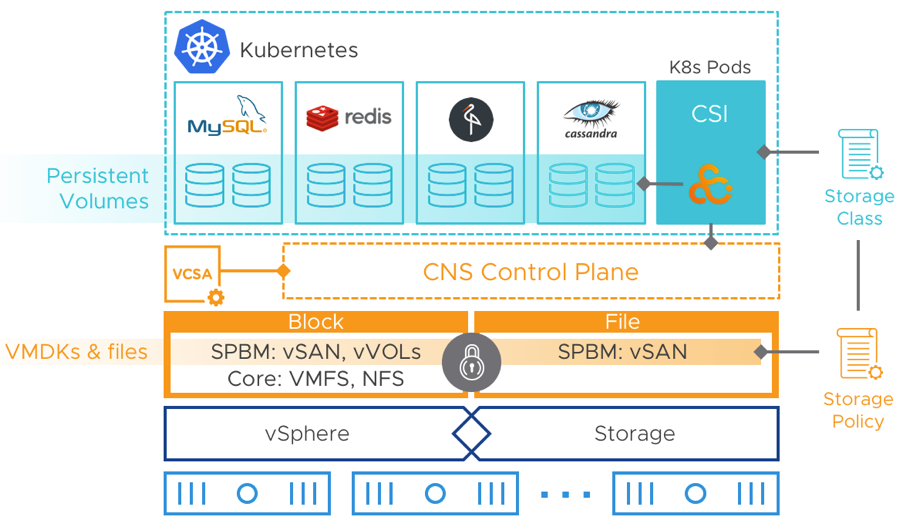VMware vSAN 7
11/03/2020

We’re excited to announce the latest release of the industry-leading hyperconverged infrastructure software, VMware vSAN 7. vSAN, with its rich ecosystem of partners, has evolved as the platform of choice for private and public clouds. This article discusses how vSAN 7 accelerates modernizing the data center with newer features and enhancements.
HCI is being rapidly adopted by organizations of all sizes, across industries to support better business outcomes. Organizations need to deliver new goods and services to customers and employees faster than ever before, as new technology is rapidly reducing product development and delivery times. IT infrastructure decision-makers need platforms that can enable quick delivery of new solutions. They’ve identified a few ways to make that happen:
• Simplify infrastructure management and accelerate provisioning
• Unify block and file storage
• Support emerging technologies, such as containers
(*Source: Perry, Christian. Voice of the Enterprise, Servers and Converged Infrastructure, Budget and Outlook, 2019. 451 Research.)
Resonating with the industry trends and needs, vSAN 7 simplifies infrastructure management by reducing the number of tools required to manage server lifecycle. Organizations can now unify block and file storage with vSAN, thus reducing the need for third party solutions and accelerating file share provisioning. vSAN 7 also includes new capabilities enhancing cloud-native applications, enabling support for file-services and vSphere add-on for Kubernetes (formerly known as Project Pacific) through VMware Cloud Foundation.
Simplify Cluster Updates with vSphere Lifecycle Manager
Lifecycle management is a time-consuming task. It is common for admins to maintain their infrastructure with many tools that require specialized skills. VMware customers currently use two different interfaces for day two operations: vSphere Update Manager (VUM) for software and drivers and server vendor-provided utility for firmware updates. In this latest release, VMware HCI sets the foundation for a new, unified mechanism to update software and firmware management that is native to vSphere called vSphere Lifecycle Manager (vLCM).
vLCM is built off a desired-state model that provides lifecycle management for the hypervisor and the full stack of drivers and firmware for the servers powering your data center. vLCM can be used to apply an image, monitor the compliance, and remediate the cluster if there is a drift. This reduces the effort to monitor compliance for individual components and helps maintain a consistent state for the entire cluster in adherence to the VMware Compatibility Guide (VCG). vLCM is a powerful new approach to creating simplified consistent server lifecycle management at scale.
Native File Services for vSAN
Native file services integrated within vSAN simplifies storage management, as it helps reduce the dependency on external solutions. vSAN 7 now supports NFS v3 and v4.1, catering to a variety of use cases. Enabling file services in vSAN is similar to enabling other cluster-level features such as iSCSI services, encryption, deduplication and compression. The entire lifecycle of provisioning and managing file services can be seamlessly performed through the vCenter UI. This feature helps address a broader set of use cases requiring file services with the simplicity of integration.
Deploy More Modern Applications on vSAN with Enhanced Cloud Native Storage
vSAN 7 extends and strengthens the cloud-native storage capabilities first introduced in vSAN 6.7 Update 3. vSAN now supports using native file services as persistent volumes for Kubernetes clusters. Persistent volumes are now able to support the use of encryption and snapshots. In addition to file services, vSAN enables vSphere Add-on for Kubernetes (formerly known as Project Pacific), which enables stateful containerized workloads to be deployed on vSAN datastores.

Overall enhancements
Integrated DRS awareness of Stretched Cluster configurations
vSAN 7 has tighter integration with data placement and DRS. After recovering from a failure condition, DRS will keep the VM running at the same site until data is fully resynchronized between the two sites. Once resynchronization is complete, DRS will move the VM to the appropriate site in accordance with DRS rules. This improvement reduces unnecessary read operations occurring across the ISL, thereby ISL resources are prioritized to complete resynchronizations post site recovery.
Immediate repair operation after a vSAN Witness Host is replaced
vSAN 7 enhances the replacement and resynchronizing logic of a vSAN Witness Host for Stretched Cluster and 2-node topologies. When a vSAN Witness Host appliance is impacted or needs to be replaced, it can be easily done using a “Replace Witness” button in vCenter. After the replacement, vSAN invokes an immediate repair operation, quickly reinstating the vSAN Witness Host to a consistent state. This enhancement helps mitigate a transient vulnerability to site-level protection by expediting vSAN Witness Host restoration.
Stretched Cluster I/O redirect based on an imbalance of capacity across sites
A vSAN Stretched Cluster topology provides the resilience of VM and data in the event of a site outage. The agility of vSAN enables administrators to fine-tune configuration parameters for individual VMs with different protection levels or affinities. As a result, there could be an imbalance of available capacity at one site versus the other. vSAN 7 introduces new intelligence to minimize impact due to capacity strained conditions. When an imbalance is detected, vSAN checks multiple parameters based on which it limits the IO to the capacity-constrained site and redirects active IO to the healthy site. These mitigation steps occur non-disruptively to the operation of the VM. This optimization is an excellent example of introducing more intelligence to vSAN to ensure predictable operation under a wide variety of conditions.
Accurate VM level space reporting across vCenter UI for vSAN powered VMs
vSAN 7 introduces a new level of consistency in VM level capacity reporting in vCenter for vSAN powered VMs. The initial design of vCenter accommodated for VM-level capacity reporting similar to how traditional storage operates. These improvements will help reconcile the reporting differences that may have been found between vSAN centric areas of vCenter and traditional VM reporting areas such as at the cluster and host view.
Improved Memory reporting for ongoing optimization
A new time-based memory consumption metric is exposed in the UI and through API to provide deeper insight into resource consumption. With the robust architecture of vSAN, as the environment evolves (through scale-up or scale-out), time-based metrics help correlate the change in memory consumption with hardware and software configuration changes made in the cluster. This helps systematically assess the impact of configuration changes and continually optimize the design.
Visibility of vSphere Replication objects in vSAN capacity views
VMware vSphere Replication is a hypervisor-based, asynchronous replication solution for vSphere VMs. It provides a simple and effective mechanism to protect and recover VMs. vSphere replication is included with vSphere Essentials Plus Kit and higher license editions. vSAN 7 introduces a significant improvement for environments using vSphere Replication. Administrators will now be able to easily identify vSphere Replication related object data at the VM object level, as well in the cluster-level capacity views. This awareness for vSphere Replication data goes a long way toward helping an administrator determine resources used for asynchronous replication needs.
Support for larger capacity devices
vSAN demonstrates great agility to meet the evolving storage needs. vSAN 7 supports newer and larger density storage devices. vSAN’s support of higher density storage devices can bring inherent improvements to customer environments, such as improved deduplication and compression ratios and a lower cost per terabyte (TB). The support for higher density drives presents a benefit unique to vSAN’s architecture: Incrementally adding or replacing existing disk groups with new disk groups consisting of much higher density drives without any additional licensing cost.
Native support for planned and unplanned maintenance with NVMe hotplug
NVMe has helped usher in all-new levels of performance capabilities for storage systems. vSphere 7 introduces one feature that meets or exceeds the capability associated with older SAS and SATA devices: Hotplug support for NVMe devices in vSphere and vSAN. This introduces a new level of flexibility and serviceability to hosts populated with NVMe devices, improving uptime by simplifying maintenance tasks around adding, removing, and relocating storage devices in hosts. Modern hosts can potentially have dozens of NVMe devices, and the benefits of hotplug most help environments large and small.
Removal of Eager Zero Thick (EZT) requirement for shared disk in vSAN
This release also introduces improved flexibility for VM applications using shared virtual disks, such as Oracle RAC. vSAN 7 eliminates the prerequisite that shared virtual disks with multi-writer flags must use the eager zero thick format. This streamlined set of requirements improves simplicity and efficiency.
Summary
vSAN 7 modernizes hyperconverged infrastructure by providing administrators a unified storage control plane for both block and file protocols, and provides significant enhancements that make it a great solution for traditional virtual machines as well cloud-native applications. vSphere Lifecycle Manager reduces the complexity of monitoring and maintaining infrastructure by consolidating software, driver and firmware update tools and introducing a desired-state model of implementing a desired image. vSAN 7’s file shares enable admins to rapidly provision a file share via a single workflow; integrated file shares also reduce dependencies on expensive third-party solutions and eases lifecycle management. As Kubernetes-orchestrated cloud-native apps will also be able to take advantage of vSAN file shares, IT can consolidate more workloads onto vSAN-powered HCI efficiently. Additional improvements provide a wide variety of benefits, from enhanced infrastructure monitoring, which helps admins plan for future needs, to future-proofing infrastructure by supporting larger capacity drives and improving uptime with NVMe hotplug. vSAN continues to be the platform of choice for both traditional applications and evolving modern applications because of seamless evolution and rapid innovation.
For more information, please refer to VMware













































